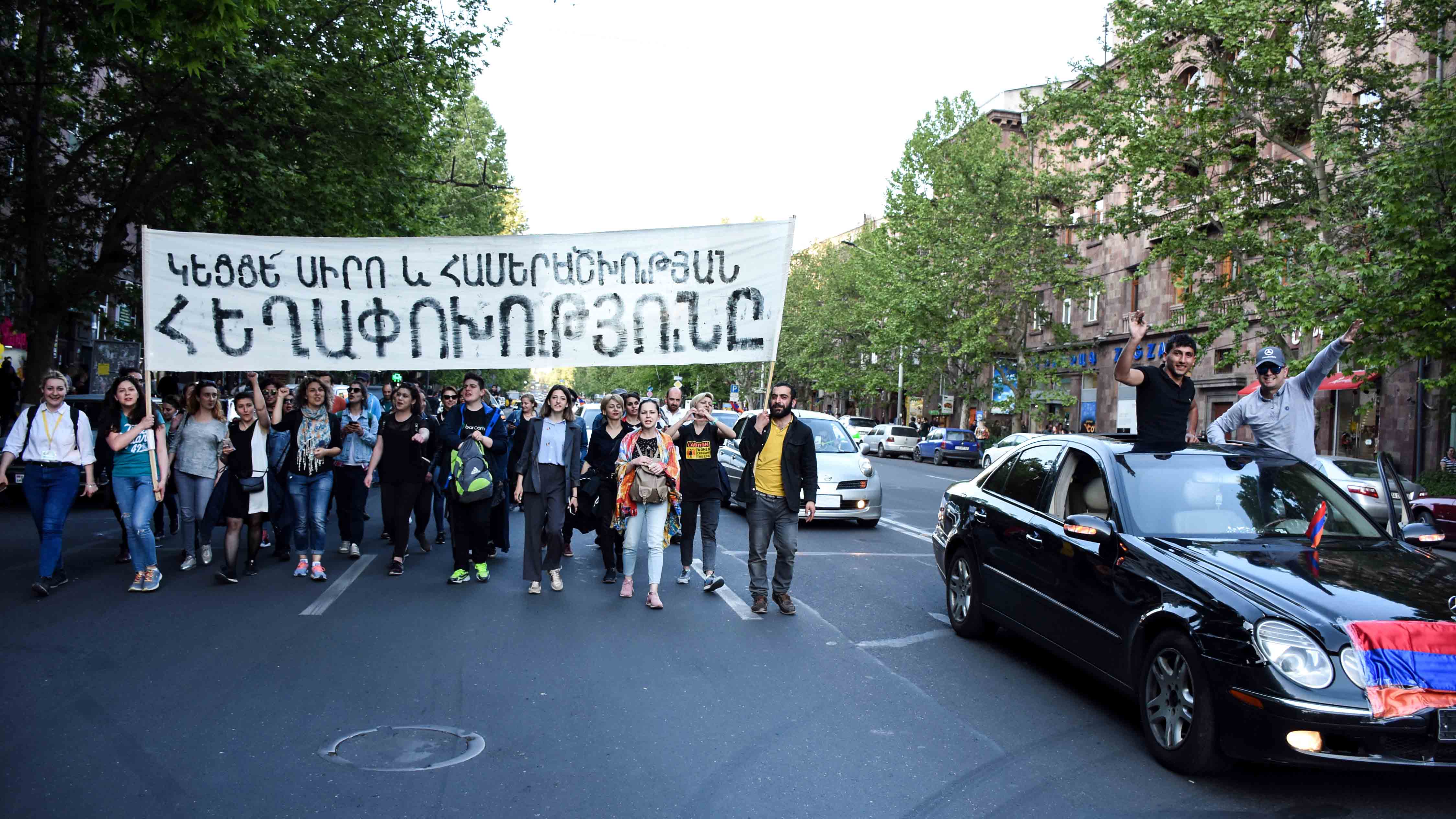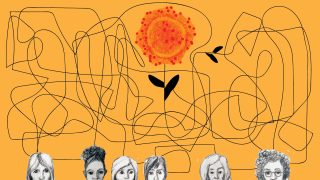
In 2010, two years after the 2008 global financial crisis, we witnessed the explosion of protest movements throughout the globe[1]. Alongside the global anti-austerity (e.g. Occupy Wall Street, the Indignados in Spain, etc.) and pro-democracy movements of the Arab Spring, there was also a rise of civic activism across some former Soviet countries including Armenia, Georgia, Russia and Ukraine (Lutsevych 2013, Ishkanian 2015).
In Armenia, both small and large-scale protests against corruption and the absence of democracy and the rule of law had become commonplace in the years leading up to the Velvet Revolution. The revolution, which took place in the Spring of 2018, led to the downfall of the Republican Party of Armenia (RPA) which had ruled the country for two decades. While many acknowledge that current Prime Minister Nikol Pashinyan is a charismatic leader who was able to mobilize and motivate people, leading to the success of the revolution, it is also unlikely that the revolution would have succeeded had there not been a politically active constituency ready to take to the streets in the initial days of the revolution. Although we may see the Velvet Revolution as a hopeful sign for democratisation in Armenia, it is also important to keep in mind that much remains to be done.
When we began this project, our focus was on understanding and analysing the causes and consequences of the shrinking space for civil society action in Armenia. The shrinking space phenomenon, as it has come to be called, has been growing around the globe and has particularly intensified in recent years. According to a recent EU report (2017), over one hundred governments, both democratic and non-democratic, have introduced ‘restrictive laws limiting the operations of civil society organisations (CSOs)’ (Youngs and Echague 2017: 5) Some argue that the shrinking space phenomenon may be due to the general decline of democracy across the world (Keane 2009, Flinders 2016), but given that this phenomenon is also occurring in democratic countries, this is not the only explanation.
While after the revolution space for civil society action in Armenia is no longer shrinking as it was under the RPA regime, it is certainly undergoing a significant transformation. Below we consider prospects for the future development of civil society in Armenia.
After the Velvet Revolution: Shifting Space for Civil Society in Armenia
It is important to recall that the movements of the 2010s articulated both political demands for greater democracy, dignity, and social justice and consisted of protests against austerity and inequality (Ishkanian and Glasius 2018). Many writing about these recent movements across the globe argue that the protests were an expression of anger and reflected growing concerns around the lack of democracy, social justice and dignity (Kaldor and Selchow 2012, Glasius and Pleyers 2013, Tejerina et al. 2013, Della Porta 2015), representing a tipping point in a globalisation of discontent (Biekart and Fowler 2013) and indignation (Calhoun 2013).Yet it has now become clear that the prospects of activists’ demands as well as their conceptions and practices of democracy, social justice, and participation bleeding outward and upward into the transformation of society and of political decision-making are very bleak. Instead, in many countries, including in Brazil, India, the Philippines, the UK and the US, nativist, right-wing populist movements have been on a rising trajectory and we increasingly hear about the crisis, death, decline of and fatigue with democracy (Keane 2009, Flinders 2016, Plattner 2015, Appadurai 2017) as scholars and pundits argue, we are now living in the period of the ‘great regression’ (Geiselberger 2017) or in the ‘age of anger’ (Mishra 2017).
The Velvet Revolution in Armenia emerged amidst these global events. Processes in Armenia are of course shaped by the country’s unique history, socio-cultural factors, and political dynamics, however, no country exists in a vacuum. As such, we consider it useful to review the experience of other post-revolutionary contexts to analyse the changing dynamics of state – civil society relations and the prospects for democratisation, civic activism, and participation in the aftermath of revolutions. This comparative review will allow us to consider the risks facing civil society in Armenia and to provide some recommendations for the future.
Prospects for Pluralism
Various scholars have argued that there tends to be a weakening of civil society in post-revolutionary contexts. Hence, whether we consider the fall of the apartheid[2] regime in South Africa in 1994 or the 2000 Serbian revolution, the 2003 Rose Revolution in Georgia (Broers 2005, Muskhelishvili and Jorjoliani 2009, Grodsky 2012), and the 2004 Orange Revolution in Ukraine (Laverty 2008, Lutsevych 2013), there are similar patterns of development (Broers 2005, Danković and Pickering 2017, Grodsky 2012, Laverty 2008, Leonard 2014, Lutsevych 2013, Muskhelishvili and Jorjoliani 2009).
On the one hand, this weakening of civil society in post-revolutionary contexts is due to ‘diminished pluralism’ (Laverty 2008) in which there is less array of opposition actors. On the other hand, scholars point to the state capture of civil society (or what some call the civil society capture of the state) in which the growing alliance between ‘political and civil society’ can result in ‘a weakening of [civic] institutions capable of holding government accountable’ (Broers 2005: 347).
Although there can be some potential benefits for civil society actors from greater inclusion in and access to government, there is also danger of becoming too close for comfort. For instance, those civil society actors who entered government in Georgia after the Rose Revolution found that they had to ‘…deal with new constituencies and adopt new objectives’ and ‘prioritise institutional objectives’ which in turn created tension between the new government representatives and their former organisations, with some of the former civic activists who entered government stating that they felt ‘betrayed’ by former colleagues (Grodsky 2012: 1702).
Since May 2018, many civil society activists have taken up posts in the new government led by Prime Minister Nikol Pashinyan. Many others, have now joined political parties, such as the Pashinyan’s Civil Contract party, or the Citizen’s Decision Social Democratic Party and following the December 9, 2018 parliamentary elections, many have now been elected to serve in the National Assembly. Some believe that these civic activists turned politicians can influence government policy from the inside. Others are more wary and fear that this influx of civic actors into state institutions and government may, as in the experiences of other post-revolutionary contexts discussed earlier, actually lead to co-option of civil society by the state and diminished ability of civil society to advocate and to hold government to account.
It is too soon to tell how state – civil society relations will develop in Armenia, but to advance democracy in the country, it will be important for the new government to protect and maintain space for civil society action. Furthermore, with regards to civil society participation in the policy process (both in the policy formulation and implementation stages), government should strive to listen to and engage with all civil society stakeholders, including radical and critical activists, rather than limiting its engagement to those who embrace more amenable, compliant, and biddable stances. There is already an instance where environmental protestors who have been holding a round the clock vigil at the Amulsar mine were physically prevented from attending a press conference organised by the Ministry of Nature Protection .
From radical opposition to reformist consensus
A second factor is that post-revolutionary contexts come with heightened expectations for the new leadership, expectations which are not easy to realise in the short term, and at times, even in the longer term. In Armenia’s case, the new government, shortly after taking power in May 2018 began to bring charges against high profile individuals, including politicians as well as others (e.g., the brother and nephews of former president Serzh Sargsyan), accusing them of corruption and the abuse of their positions. This is unsurprising given how PM Pashinyan, while still a MP, had often denounced the growing corruption and the power of the RPA-affiliated oligarchs who had emerged during the privatization process that began after the collapse of the USSR.
During the revolution, Pashinyan’s demands for then PM Serzh Sargsyan’s resignation and an end to oligarchic rule, corruption, and impunity in the country resonated with many citizens of Armenia who had wearied of the status quo. Yet, speaking out against corruption is one thing, tackling it is another. Similarly while Pashinyan has often spoken about the need to tackle poverty in Armenia, it is clear that it will not be easy to alleviate poverty or address issues of growing inequality without implementing changes to the country’s current economic and social policy models. At present, it does not appear that either Pashinyan or the Civil Contract Party is preparing to abandon the neoliberal policies which were introduced after 1991 and to embrace social democratic policies which will consist of increased welfare spending and redistributive and progressive tax policies.
If we again draw on the historical and comparative literature, it is clear that in addition to the dangers posed by the state capture of civil society, the persistence of neoliberal policies can also lead to subsequent discontent in post-revolutionary contexts. For example, according to Muskhelishvili and Jorjoliani the ‘decline of democracy in post-revolutionary governance’ in Georgia was not solely caused only by the capture of civil society by the state or by Saakashvili’s centralized, populist, and arbitrary rule (i.e., diminished pluralism). On the contrary, they maintain that a key factor which led to Saakashvili’s downfall was his government’s ‘ideological – neoliberal and even libertarian – stances which underpinned the new reformist strategies’ (Muskhelishvili and Jorjoliani 2009: 694).
Similarly, in South Africa after the fall of the apartheid regime and the election of Nelson Mandela, the African National Congress (ANC) was limited in its ability to veer away from the neoliberal policies advanced by powerful bilateral and multilateral aid agencies which had flocked to the country after the end of apartheid. While donor aid was plentiful, ‘it was difficult to formulate a new radical vision’ and to ‘challenge the neoliberal system’ (Leonard 2014: 381). In this context certain NGOs, which had close relationships with donors and the ANC government, but who were not seen as accountable to the grassroots, proved unable (or unwilling) to ‘advance the concerns of the marginalised to exert influence in political society’ (Leonard 2014: 385). This led to a splintering of civil society in South Africa into more compliant and radical organisations. This splintering of civil society is far from being unique to South Africa. Indeed in many countries, including in Armenia (Ishkanian 2015), there has been and continues to be a splintering of civil society groups and a growing critique of those NGOs that become ‘too close’ to donors and governments, thereby losing their ability to advance more radical positions and critiques (Banks, Hulme, and Edwards 2015, Glasius and Ishkanian 2015, Lutsevych 2013, Eikenberry 2009). Indeed, one may argue that this diversity of organisations is a key aspect of a healthy civil society.
Until recently, left leaning civil society activists in Armenia have spearheaded the critique of neoliberal policies in the country, highlighting how these have led to growing poverty and inequality. Yet these activists do not represent a large constituency and continue, for the most part, to be marginalized. This is evidenced also by the small number of votes garnered in the 9 December parliamentary elections by the newly created left-wing social democratic political party, Citizen’s Decision. Furthermore, the case of the Amulsar gold mine, is often framed as key example of how neoliberal policies and logics, which prioritise the interests of foreign investors and corporations over the environment as well as the health and well-being of Armenian citizens, continue to dominate policy thinking. Some describe the battle over the future of Amulsar as the ‘first major crisis’ of the post-revolutionary government (Liakhov and Khudoyan 2018). At the time of writing (December 2018), the situation of the mine remains unresolved. In coming months, it will be important to examine whether the demands and interests of the mining company will override the concerns of local citizens living near the mine as well as those of environmental activists from other parts of Armenia and the Armenian diaspora, who have raised concerns about the risks posed by the Amulsar mine to the health, safety, and well-being of local communities and the natural environment. Yet, if these activists’ voices will be ignored, as indicated by the incident which occurred in November 2018, this does not bode well for the future of civil society – state relations.
Scholars writing about the resilience of neoliberalism globally, argue that civil society actors, and in particular social movements, have an important role to play in articulating challenges against neoliberal ideas and policies. Crouch refers to civil society as ‘a fourth force’ which is beyond the ‘triangular confrontation among the state, market, and the corporation’ and which can ‘criticize, harry, and expose the misdeeds and abuses of the cosy triangle’ (Crouch 2011: x). Crouch does not go so far as to claim that ‘the busy, but small voices of civil society’ can create a ‘different social order from the corporation-dominated capitalism’ but he sees an opportunity for civil society to ‘make life far better than states and corporations will do if left to themselves’ (Crouch, 2011: x). Peck et al. also see an opportunity for social movements, but recognise the difficulties involved in taking ‘home-grown and organic initiatives, grassroots innovation, and socially embedded strategies’ and moving them ‘to other places’ so as to create a globalised resistance to neoliberalism (Peck, Theodore, and Brenner 2012: 27). Thatcher and Schmidt argue that there has not been a Polanyian countermovement to the rise of neoliberalism, but hold out hope that ‘new ideas’ and ‘interest coalitions’ will emerge (2013: 421) and identify ‘social movements’ as demonstrating ‘the greatest move away from neo-liberal ideas, at least at the level of political discourse’ (Thatcher and Schmidt 2013: 426).
Thus, from the perspective of advancing policies which prioritise social justice, ensuring space for civil society action in Armenia will be important. Many civil society activists have told us that they are for the moment refraining from being too critical and are awaiting for the new government to become more consolidated. Yet, they also indicate that this détente will not last forever and that the new government should be open to receiving criticism from and being held accountable by civil society. This will mean that the government provides space for genuine participation and consultation rather than box ticking exercises which limit the participation to only non-contentious, conformist civil society groups. The government should also ensure freedom of participation and speech for all citizens of the Republic of Armenia by valuing, respecting and promoting the rights and dignity of individuals regardless of disability, gender, sexual orientation, ethnicity, or religion. Finally, it will be important to have a free and independent press, which has been shown to be crucial for democracy and rule of law (Themudo 2013). All of the above factors will be crucial for how civil society – state relations develop in Armenia after the Velvet Revolution. Civil society can be hopeful, but it should also remain vigilant.
Dr. Armine Ishkanian
Associate Professor Department of Social Policy, LSE
Photo credit: Narek Aleksanyan
[1]The article is written in the framework of Socioscope’s “Shrinking Space to Post-Revolutionary Space: Reimagining the Role and Relations of Civil Society in Armenia” research. The research has been implemented by the financial support of the South Caucasus Office of Heinrich Boell Foundation. The content of the research, implemented by Socioscope, may not necessarily reflect the opinion of the Foundation. [2]In this article consider post-apartheid South Africa as a post-revolutionary context due to the revolutionary level of changes and social transformation it engendered.References
- Appadurai, Arjun. 2017. ‘Democracy fatigue.’ In The Great Regression edited by Heinrich Geiselberger, 1-12. Cambridge: Polity. Banks,
- Nicola, David Hulme, and Edwards Edwards. 2015. ‘NGOs, States, and Donors Revisited: Still Too Close for Comfort.’ World Development 66:717-718.
- Biekart, Kees, and Alan Fowler. 2013. ‘Transforming Activisms 2010+: Exploring Ways and Waves.’ Development and Change 44 (3):527-546.
- Broers, Laurence. 2005. ‘After the ‘revolution’: civil society and the challenges of consolidating democracy in Georgia.’ Central Asian Survey 24 (3):333-350.
- Calhoun, Craig. 2013. ‘Occupy Wall Street in perspective.’ British Journal of Sociology 64 (1):26-38.
- Crouch, Colin. 2011. The Strange Non-Death of Neoliberalism Cambridge: Polity Press.
- Danković, Sladjana, and Paula M Pickering. 2017. ‘Public scepticism of internationally supported civil society organisations: norms, citizen priorities, and local groups in post-socialist Serbia.’ East European Politics, 33 (2):210-232.
- Della Porta, Donatella. 2015. Social Movements in Times of Austerity. Cambridge: Polity Press.
- Eikenberry, Angela. 2009. ‘Refusing the Market: A Democratic Discourse for Voluntary and Nonprofit Organizations.’ Nonprofit and Voluntary Sector Quarterly 38 (4):582-596.
- Flinders, Matthew. 2016. ‘The Problem with Democracy.’ Parliamentary Affairs 69 (2):181-203.
- Geiselberger, Heinrich, ed. 2017. The Great Regression. Cambridge: Polity.
- Glasius, Marlies, and Armine Ishkanian. 2015. ‘Surreptitious Symbiosis: Engagement between activists and NGOs.’ Voluntas 26 (6):2620-2644.
- Glasius, Marlies, and Geoffrey Pleyers. 2013. ‘The Global Moment of 2011: Democracy, Social Justice and Dignity.’ Development and Change 44 (3):547-567.
- Grodsky, Brian. 2012. ‘Co-optation or Empowerment? The Fate of Pro-Democracy NGOs after the Rose Revolution.’ Europe-Asia Studies 64 (9):1684-1708.
- Ishkanian, Armine. 2015. ‘Self-Determined Citizens? New Forms of Civic Activism and Citizenship in Armenia ‘ Europe-Asia Studies 67 (8):1203-1227.
- Ishkanian, Armine, and Marlies Glasius. 2018. ‘Resisting neoliberalism? Movements against austerity and for democracy in Cairo, Athens and London.’ Critical Social Policy online first 1-20.
- Kaldor, Mary, and Sabine Selchow. 2012. The ‘Bubbling Up’ of Subterranean Politics in Europe. Civil Society and Human Security Research Unit, London School of Econoimcs.
- Keane, John. 2009. The Life and Death of Democracy. . New York: Simon & Schuster.
- Laverty, Nicklaus. 2008. ‘The Problem of Lasting Change: Civil Society and the Colored Revolutions in Georgia and Ukraine.’ Demokratizatsiya 16 (2):143-161.
- Leonard, Llewellyn. 2014. ‘Characterising civil society and the challenges in post-apartheid South Africa.’ Social Dynamics: A journal of African studies 40 (2):371-391.
- Liakhov, Peter, and Knar Khudoyan. 2018. ‘How citizens battling a controversial gold mining project are testing Armenia’s new democracy.’ Last Modified 7 August 2018. https://www.opendemocracy.net/od-russia/peter-liakhov-knar-khudoyan/citizens-battling-a-controversial-gold-mining-project-amulsar-armenia.
- Lutsevych, Olga. 2013. How to Finish a Revolution: Civil Society and Democracy in Georgia, Moldova and Ukraine. London: Chatham House.
- Mishra, Pankaj. 2017. The Age of Anger: A History of the Present. London: Penguin.
- Muskhelishvili, Marina, and Gia Jorjoliani. 2009. ‘Georgia’s ongoing struggle for a better future continued: democracy promotion through civil society development.’ Democratization 16 (4):682-708.
- Peck, Jamie, Nik Theodore, and Neil Brenner. 2012. ‘Neoliberalism, interrupted.’ In Neoliberalism: Beyond the Free Market, edited by Damien Cahill, Lindy Edwards and Frank Stillwell, 15-30. Cheltenham: Edward Elgar.
- Plattner, Marc F. 2015. ‘Is Democracy in Decline.’ Journal of Democracy 26 (1):5-10.
- Tejerina, Benjamin, Ignacia Perugorria, Tova Benski, and Lauren Langman. 2013. ‘From indignation to occupation: A new wave of global mobilization.’ Current Sociology 61 (4):377-392.
- Thatcher, Mark, and Vivien A. Schmidt. 2013. ‘Conclusion: Explaining the resilience of neo-liberalism and possible pathways out.’ In Resilient Liberalism in Europe’s Political Economy, edited by Vivien A. Schmidt and Mark Thatcher, 403-431. Cheltenham: Edward Elgar.
- Themudo, Nuno. 2013. ‘Reassessing the impact of civil society: nonprofit sector, press freedom, and corruption.’ Governance 26 (1):63-81.
- Youngs, Richard, and Ana Echague. 2017. ‘Shrinking space for civil society: the EU response ‘. Directorate General for External Policy Department Accessed 20 November 2018. http://www.europarl.europa.eu/RegData/etudes/STUD/2017/578039/EXPO_STU(2017)578039_EN.pdf.





